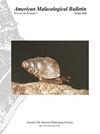The Biology and Functional Morphology of Curvemysella paula (A. Adams, 1856) (Bivalvia: Galeommatoidea: Montacutidae) Commensal with Diogenes goniochirus Forest, 1956 (Crustacea: Paguridea) on China Beach, Danang, Vietnam.
IF 0.4
4区 生物学
Q4 MARINE & FRESHWATER BIOLOGY
引用次数: 6
Abstract
Abstract: The Indo-West Pacific montacutid Curvemysella paula(A. Adams, 1856) is the sole representative of its genus and the only known bivalve that is an obligate commensal of hermit crabs. As such, studies on it are accordingly very few. It lives in small groups byssally attached to the internal columella of the host's adopted shell. This paper describes the species from a wave-exposed beach in central Vietnam at Danang. Here, it was living with Diogenes goniochirus, but elsewhere in Hong Kong and Japan other taxa serve as hosts. The adult shell of C. paula is antero-ventrally long, deeply concave ventrally and so inequivalve as to appear twisted. Smaller individuals are more equivalve and equilateral and become deformed with age and growth. The hinge plate has a structure typical of the Montacutidae with the ligament ventrally formed into a lithodesma. Anatomically, C. paula is also unremarkable and interest in it focuses on reproduction. The species lives in small groups, the oldest and largest being a female, the smallest and youngest males. Intermediate sized individuals are hermaphroditic. Curvemysella paula is thus a protandric consecutive hermaphrodite. Prodissoconch morphology suggests that C. paula does not ctenidially brood fertilised eggs or, if so, only briefly. Further, it seems likely that there is subsequently an abbreviated lecithotrophic period of development perhaps undertaken close to the sea bed - thereby keeping the larvae close to established hermit crab and parental bivalve populations.越南岘港中国海滩paula (A. Adams, 1856)(双壳亚目:Galeommatoidea: Montacutidae)与Diogenes goniochirus Forest, 1956(甲壳纲:Paguridea)共生的生物学和功能形态。
摘要:印度-西太平洋山地Curvemysela paula(A.Adams,1856)是其属的唯一代表,也是已知的唯一一种寄居蟹专性共生的双壳纲动物。因此,对它的研究很少。它通过附着在宿主收养的外壳的内部小柱上而成小群生活。本文描述了越南中部岘港一个暴露在海浪中的海滩上的物种。在这里,它生活在Diogenes goniochirus,但在香港和日本的其他地方,其他分类群作为宿主。泡桐成虫壳前腹面长,腹面深凹,不均匀,呈扭曲状。体型较小的个体更为等长,并随着年龄和生长而变形。铰链板具有典型的Montacocutidae结构,腹面韧带形成石结。在解剖学上,C.paula也不起眼,对它的兴趣集中在繁殖上。该物种生活在小群体中,年龄最大和最大的是雌性,最小和最年轻的雄性。中等大小的个体是雌雄同体的。因此,保氏Curvemysela是一种前体连续的雌雄同体。Prodissoconch形态表明,C.paula不会通过栉孔繁殖受精卵,或者,如果是的话,只是短暂地繁殖。此外,似乎随后可能会在靠近海床的地方出现一个短暂的无营养发育期,从而使幼虫靠近已建立的寄居蟹和双壳类亲本种群。
本文章由计算机程序翻译,如有差异,请以英文原文为准。
求助全文
约1分钟内获得全文
求助全文
来源期刊
CiteScore
1.00
自引率
40.00%
发文量
1
审稿时长
>12 weeks
期刊介绍:
The American Malacological Bulletin serves as an outlet for reporting notable contributions in malacological research. Manuscripts concerning any aspect of original, unpublished research,important short reports, and detailed reviews dealing with molluscs will be considered for publication. Recent issues have included AMS symposia, independent papers, research notes,and book reviews. All published research articles in this journal have undergone rigorous peer review, based on initial editor screening and anonymous reviewing by independent expertreferees. AMS symposium papers have undergone peer review by symposium organizer, symposium participants, and independent referees.

 求助内容:
求助内容: 应助结果提醒方式:
应助结果提醒方式:


